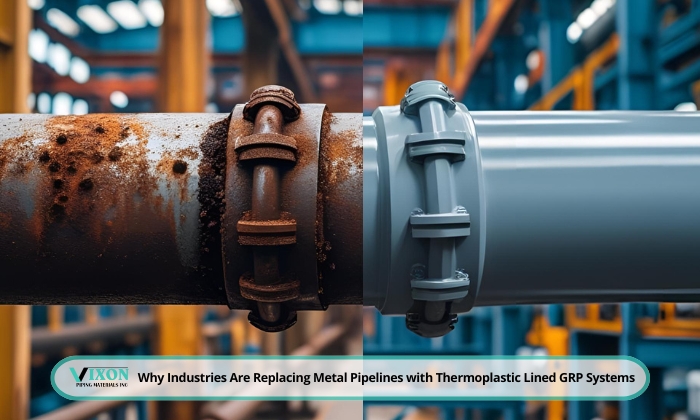In many industrial sectors, piping systems form the lifeline of operations, transporting aggressive chemicals, high-pressure fluids, or corrosive slurries. Traditionally, metal pipelines such as carbon steel or stainless steel have been the default option. However, a significant shift is underway. More and more industries are replacing metal pipelines with thermoplastic lined GRP (Glass Reinforced Plastic) systems, and for good reasons.
The Limitations of Metal Piping Systems
Metal pipes have long been appreciated for their strength and pressure-handling capacity, but they come with critical limitations:
- Corrosion Susceptibility: Even stainless steel can suffer in environments with strong acids, alkalis, or saline conditions.
- Heavy Weight: Metal pipes are heavy, leading to expensive transportation, handling, and installation.
- High Maintenance Costs: Frequent repairs, corrosion inhibitors, and repainting can significantly increase the total cost of ownership.
- Shorter Lifespan in Harsh Conditions: Metal can degrade faster in industries like chemical processing or wastewater treatment.
As industries demand longer-lasting, corrosion-proof, and cost-efficient piping systems, thermoplastic lined GRP has emerged as an innovative solution.
What Is Thermoplastic Lined GRP Piping?
Thermoplastic lined GRP piping combines two materials to create a high-performance composite pipe:
- GRP (Glass Reinforced Plastic): This is a lightweight, high-strength outer layer made from resin reinforced with glass fibers.
- Thermoplastic Liner: The inner lining made from materials like PP (Polypropylene), PVDF (Polyvinylidene Fluoride), PTFE (Teflon), or ECTFE resists corrosion and chemical attack.
Together, these layers deliver the structural integrity of GRP and the corrosion resistance of thermoplastics, making the system ideal for handling aggressive or hazardous media.
Key Benefits of Thermoplastic Lined GRP Systems Over Metal Pipes
Superior Corrosion Resistance
Unlike metal, which corrodes over time when exposed to aggressive chemicals or salty environments, thermoplastic lined GRP pipes are chemically inert. This ensures a longer lifespan and safer fluid handling, especially in chemical, mining, and desalination industries.
Lightweight Design
GRP pipes weigh significantly less than metal ones, reducing shipping costs and making installation faster and more economical no need for heavy lifting equipment in many cases.
Reduced Maintenance and Downtime
Thermoplastic linings offer a smooth surface that resists scaling and fouling. This results in less cleaning, fewer shutdowns, and a more efficient operation overall.
Long-Term Cost Efficiency
Although the initial cost may seem higher than standard metal pipes, the lifecycle cost of thermoplastic lined GRP is much lower due to reduced maintenance, longer service life, and better chemical resistance.
Thermal and Electrical Insulation
GRP is non-conductive and has good thermal insulation properties, eliminating the need for extra insulation in many applications.
Customizability
Manufacturers can customize GRP systems with different thermoplastic liners to match the specific media and temperature conditions of the application.
Industries Leading the Shift
Chemical Processing Plants
Highly aggressive acids, alkalis, and solvents make corrosion a constant threat. GRP pipes lined with PTFE or PVDF can handle extreme pH ranges and high temperatures with ease.
Water and Wastewater Treatment
Municipalities and private plants are using lined GRP systems for transporting wastewater, treated water, and even brine from desalination processes thanks to its excellent corrosion and abrasion resistance.
Oil & Gas
Offshore and onshore operations deal with hydrogen sulfide, chlorides, and other corrosive agents. Thermoplastic lined GRP offers a non-corrosive and long-lasting alternative to costly alloy metals.
Pharmaceutical and Food Industries
Where hygiene and purity are critical, non-metallic systems with smooth, inert linings help prevent contamination and maintain flow consistency.
Cost Comparison: Metal vs. Thermoplastic Lined GRP
| Criteria | Metal Pipes | Thermoplastic Lined GRP |
|---|---|---|
| Initial Cost | Medium | Slightly High |
| Maintenance Cost | High | Low |
| Corrosion Resistance | Moderate to Low | Very High |
| Installation Time & Cost | High (heavy & complex) | Low (lightweight & simple) |
| Lifespan | 10–15 years | 25+ years |
| Total Cost of Ownership | High | Significantly Lower |
Future Outlook: The Rise of Composite Piping Solutions
As industries continue to emphasize sustainability, cost efficiency, and safety, the adoption of thermoplastic lined GRP piping systems is expected to grow significantly.
With advancements in composite materials and installation technology, lined GRP pipes are becoming increasingly accessible and economically viable even for mid-sized industries. Moreover, with growing regulations against leakage, corrosion, and environmental contamination, lined GRP is the smart choice for forward-thinking operations.
Thermoplastic Lined GRP Piping Systems Alternative to Metal Pipelines
The replacement of metal pipelines with thermoplastic lined GRP systems is not just a trend it’s a long-term strategy for industries seeking enhanced performance, reduced costs, and maximum reliability.
By leveraging the dual benefits of strength and chemical resistance, this hybrid solution meets the complex demands of modern infrastructure. Whether you’re planning a new facility or upgrading an old one, it’s time to explore how thermoplastic lined GRP can future-proof your piping systems.

